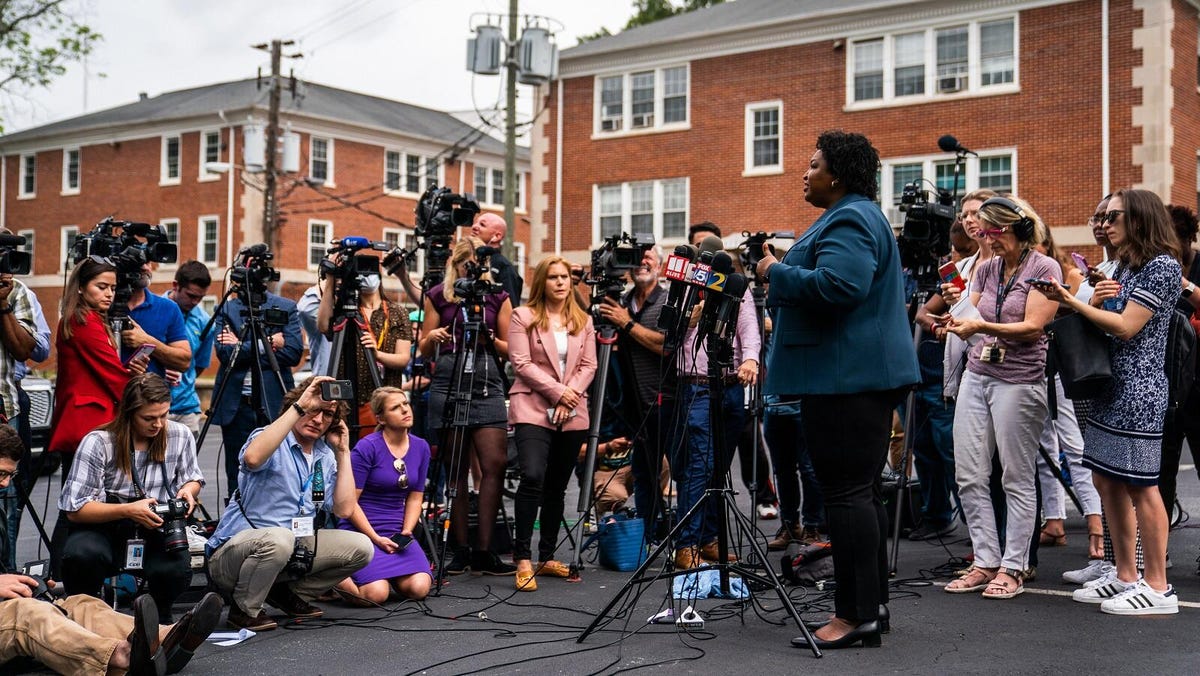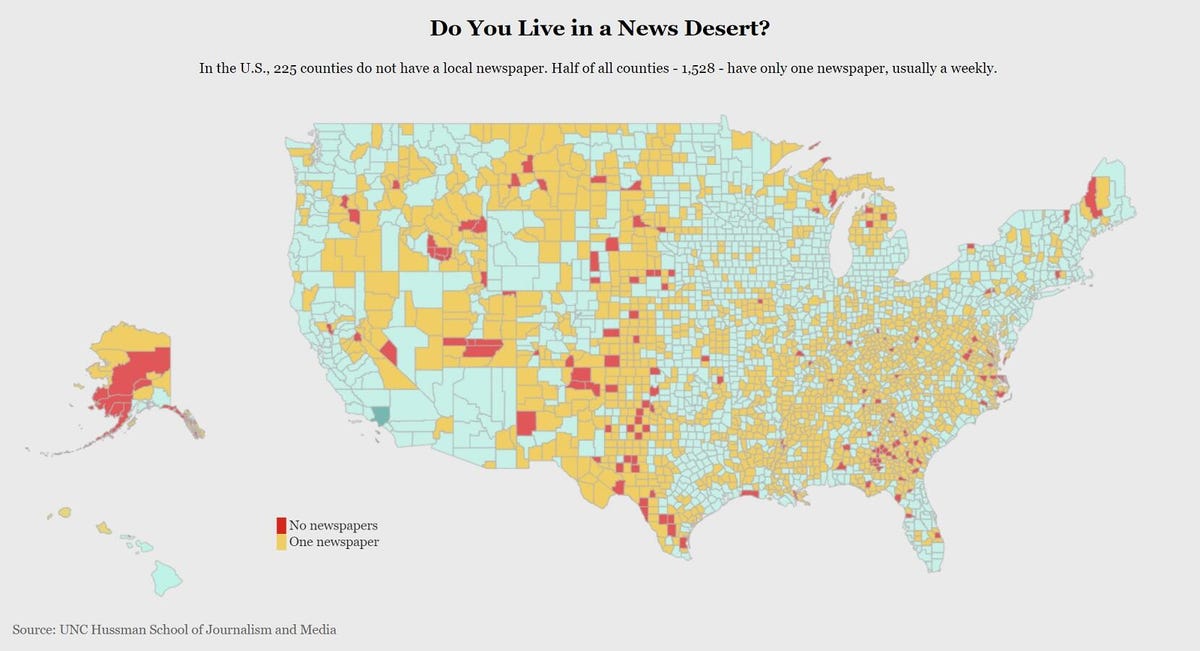When local newspapers fold polarization rises here s my number so call me maybe when local newspapers fold polarization rises here synonyms when local newspapers fold polarization definition when local newspapers fold polarization of light when local newspapers folder when local newspapers fold3 when local newspapers folds

When Local Newspapers Fold, Polarization Rises. Here's What You Can Do
Russia's invasion of Ukraine, rising energy costs and our ongoing struggles with the coronavirus pandemic take up a lot of our attention these days. But there's more going on a lot closer to home -- you just might not know it, because your local newspaper is gone.
More than a quarter of hometown newspapers have disappeared in the last century, leaving about 70 million Americans with little or no way to stay informed about their city and county governments, schools or businesses. As the country heads toward the 2022 midterm elections, Americans are increasingly turning to friends and social media to stay informed -- which isn't always trustworthy, as we learned during the 2016 election when around 44% of Americans were exposed to disinformation and misinformation through untrustworthy websites.
"The state of local news in America is dire," said Tim Franklin, senior associate dean of Northwestern's Medill School of Journalism and head of the Medill Local News Initiative.
Local journalism isn't just a nice idea. Community newspapers report some of the most important stories in our country. That includes the Boston Globe's 2002 series exposing the Catholic Archdiocese of Boston's sex abuse of minors, Sara Ganim and The Patriot-News' coverage revealing Penn State sex abuse scandal involving Jerry Sandusky and the Charleston Gazette-Mail's 2017 expose on opioids flooding into West Virginia.

This is part of Citizen Now, a package that aims to empower readers with information about our changing world.
CNETBut for every Pulitzer Prize-winning local journalism story, there are countless more that have served as chroniclers of their communities and watchdogs of the people in power. And when they aren't there, research from the Brookings Institute found there's generally more government waste and fraud.
"When you have less local news, there's various effects, some of which you'd find predictable: lower voting turnout, more corruption, more waste," said Steven Walden, president and co-founder of Report For America, a nonprofit that funds young reporters to work in understaffed newsrooms throughout the US. "There's also evidence that you have more polarization and misinformation."
The journalism industry has been struggling to adapt. Advertising, once a vital part of the newspaper world, has shifted to online. Meanwhile, profit-hungry newspaper owners have chosen to lay off staff and reduce the quality of their products.
Nonprofit organizations have stepped up to support newsrooms in several ways, but ultimately, they live or die by their communities. Many local papers and radio stations depend on individual donations to fund reporting that would never be done by larger publications, covering civic meetings and investigating local issues that lead to exposés which fix injustices. Even simply signing up for and reading local news draws people closer to issues that affect them -- and reinforces what publications do.
"Most of these stories weren't big but they mattered immensely to the residents in a community larger outlets didn't regularly cover," said Greg Yee, now a reporter at the Los Angeles Times, speaking about his year writing for the Farmington Daily Times in Farmington, New Mexico. (Full disclosure: Yee is a former colleague of this article's author.) Stories that stick out from that time include a mobile home park cut off from natural gas in winter and a new gas station opening in a Navajo Nation community, the only fuel access in 30 miles, that significantly improved locals' quality of life.
"A good local news organization is a problem solver: it identifies problems and helps a community come together to solve it," said Penelope Abernathy, visiting professor at Northwestern's Medill School of Journalism, who heads a site dedicated to mapping news deserts, areas with one or zero local papers. "And a good news organization shows you how you are related to people you may not know you're related to in another part of the county, region or state."

Long, withering decline
Journalism jobs have been shrinking for decades, driven by declining newspaper circulation and the rise in digital advertising. The news industry's advertising and subscription businesses have roughly halved over the past decade. Much of that money's shifted to Google, Facebook and Amazon, which together now hold 64% of the US online advertising market.
For newspapers, that shift in spending is catastrophic. In the decade after the great recession in 2009, the Pew Research Center found newspaper newsroom employment in the US had dropped by more than half, to about 35,000 workers.
Ironically, the news industry has more readers than ever before – upwards of 10 times as many, according to Danielle Coffey, vice president and general council of the News Media Alliance.
"We don't have a broken product. It's being consumed at exponential rates," she said. "The source of the problem is the revenue problem."
It wasn't always this way.
The founding fathers believed so strongly in newspapers as a public good that they set up government subsidies for postal rates, reducing the cost of distributing the news – which at the time, was delivered on horseback.
In the 1960s and '70s, though, publicly traded paper owners began fixating on profits. To impress shareholders, news organizations conglomerated into big chains that gobbled up local papers into regional networks, said Amanda Lotz, professor of the Digital Media Research Centre at Queensland University.
"The financialization pressure really moves [newspapers] away from the balance between a commercial and public service enterprise of providing news to a community," Lotz said.
Rounds of acquisitions resulted in the gutting of editorial budgets and staff. With fewer reporters, newspapers started relying on national stories published by wire services, a trend that created "ghost papers" that had little or no local content. Meanwhile, the internet became an easy substitution for things online that had until then been exclusive to the paper, like weather, sports scores, classifieds and even news.
Venture capitalists and other financial firms began buying up newspapers in the 1980s but rapidly accelerated in the last two decades, growing to own over 23% of US newsrooms today while wringing out profits with more layoffs.
"Those losses put more strain on already stretched newsrooms and the publications ended up churning through staff," said Yee, who worked for four years at a pair of newspapers owned by hedge fund Alden Global Capital. "All of that translates into worse, inconsistent coverage of the communities they're trying to serve."
As a result, from 2004 until the start of the pandemic in 2020, the US lost a quarter (around 2100) of its newspapers, according to a report from the University of North Carolina's Hussman School of Journalism and Media. By the end of last year, another hundred were gone, Poynter reported, expanding news deserts that are mostly located in financially-impacted rural areas in the country's interior.
Some papers have tried to rely more heavily on subscriptions, while transitioning to mainly digital publishing. Some success stories include the Chattanooga Times Free Press, which has been operating since 1869. Last September, it switched to a daily digital edition and a single print edition on Sunday from a daily print edition. The publication spent $6.1 million to give all its monthly subscribers iPads and train them one-on-one how to use them to access their daily paper, and it's retained subscribers through the transition.
"There are some real success stories in this transition. If you can lower your paper costs and your distribution costs and if you can attract enough digital subscribers, you can support a local newsroom on that. But many local news organizations are still getting a significant chunk of their revenue from print advertising," Medill's Franklin said.

Legislative fix, maybe
One way the news industry could regain revenue and profit is to seek compensation from big tech platforms. After all, advocates say, Facebook, Google, Twitter make money selling ads next to links, videos and photos published and shared freely to their networks.
Legislators in Australia were the first to pass a law in February 2021 requiring Google and Facebook to negotiate with publishers for compensation to use their work, while France followed with its own legislation shortly thereafter. The latter locked horns with Google before finally securing legal assurance that the search giant would pay local media outlets when they appear in search results. Critics like the Electronic Frontier Foundation lament that the Australian and French laws ensured deals for big media publishers at the expense of smaller ones, but that hasn't stopped Canada and the UK from gearing up to pass their own versions.
A version of that idea in the US, called the Journalism Competition and Preservation Act, was proposed in March, 2021 by Senators Amy Klobuchar, Rand Paul, Cory Booker, and Lindsey Graham -- a rare bipartisan effort. The bill would allow news organizations to collectively bargain with tech companies for compensation, but hasn't moved out of committee yet.
Another idea to fund journalism Is the Local Journalism Sustainability Act introduced a year ago in the House by Representatives Ann Kirkpatrick and Dan Newhouse. That bill, if it were to become law, would give newsrooms around $50,000 annually in tax breaks to hire reporters. Small businesses, meanwhile, would receive $5,000 for the first year to advertise in local papers, and Americans would get a $250 stipend to pay for news subscriptions. It's unlikely to pass, though, in part because of partisan bickering over other spending plans on Capitol Hill.
"We need to make sure these publications can sustain themselves through this crisis and beyond, and I believe the credits in this bill make significant progress in providing a pathway to that sustainability," Rep. Kirkpatrick said when announcing the bill.
Nonprofit newsrooms
Some news organizations are finding funding beyond ads and subscriptions. Nonprofit foundations and philanthropic organizations are funneling grants and other aid money to newsrooms, including a new wave of nonprofit publications, like ProPublica, which run mostly on foundation and individual donations.
The American Journalism Project is a self-described venture philanthropy firm that to date has raised $90 million to back 32 local nonprofit newsrooms. Founded in 2019, it's also helped launch four more, taking the startup incubation model and applying it to digital newsrooms.
The organization focuses on both funding newsrooms and guiding them toward self-sustainability by diversifying their revenue streams, said Sarabeth Berman, CEO of the American Journalism Project. Newsrooms they've helped grow by around 67% in their first year and are projected to double their revenue in three years.
"Will local news only be nonprofit? No. Is nonprofit news vital for the future of an informed citizenry? We think so," Berman said.
Report For America, founded in 2017, describes itself as a service organization, which helps pair young reporters fresh out of college with legacy newsrooms. The organization financially supports the reporter by paying half their salary (up to $25,000) the first year, then a third (up to $20,000) the following year. After that, it's up to the publication to decide whether to hire them permanently.
"If you're not in New York or Boston or Washington, some of these news organizations have trouble getting people to go out to smaller towns," said Report For America's Waldman. "We have a very significant recruiting operation and are able to create a sort of self-selected group of people who are really passionate about local."
Report For America has grown its graduating class to 130 reporters this year, up from its first class of 13 in 2018 -- to date, over 560 reporters have gone through the program and partnered with local newsrooms. They include Laura Roche of the Charlotte News & Observer writing about the fraught debate over museums returning the unethically sourced remains of Black people, Sierra Clark of the Traverse City Record-Eagle writing about Melissa Isaac and many others in her Anishinaabek Neighbors series, and Brandon Drenon of the Indianapolis Star writing about the NAACP and others criticizing Indiana schools for failing Black students.
Report for America also connects newsrooms with donors in their area in an effort to get the community more involved in funding its local news again.
"Our goal is to actually help change the local business models in a way that they can sustain that," Waldman said.
The nonprofit Knight Foundation pledged to give $300 million to news organizations in 2019, some of which will go to both the American Journalism Project and Report For America, among other nonprofits that in turn support local newsrooms -- efforts that can be seen city by city on this interactive map. The flow of financial support is important for local newsrooms that operate on nonprofit and for-profit models, which are both valuable to their communities, said Jim Brady, vice president of the Knight Foundation's journalism program.
"Nonprofits tend to be more investigative or enterprise in nature, and the for-profits tend to provide more information on how consumers can live their daily lives. So we think both must be part of the answer to how local news can thrive," Brady said.

An infographic from the UNC Hussman School of Journalism and Media's project website, The Expanding News Desert, headed by Penelope Abernathy.
UNC HussmanWhat to do if you don't have local journalism
News experts have advice for what to do if you live in a news desert, with little or no coverage. First on the list: Stop thinking that social media posts are an informative replacement for reporting. Social media can help people know what's going on, but it's rife with bias and misinformation.
"There's a proliferation of misinformation and disinformation that goes unchecked because there's no local journalist checking on the facts. [Social media is] a place where unvetted gossip can get spread," Franklin said.
People need to learn to spot misinformation that's spread on social media by publications that look like they're trustworthy but aren't. Both the World Health Organization and the Poynter Institute have their own free online courses to learn how to fact-check posts yourself -- not just to spot fake news, but also to understand the agenda behind why they're spreading in the first place.
In the voids left by local papers, citizen journalists and bloggers have stepped up to provide their communities with informative coverage, but they lack the oversight and vetting a newsroom provides. For lack of better options, a citizen reporter could start a site on Substack and write about local events, Franklin suggested.
The best thing to do is to reach out to regional papers the next town over and request coverage. You can find your nearest local or regional paper on Newspapers.com or NewspaperMap.com. The Corporation for Public Broadcasting has a station finder site too, and if you're a fan of National Public Radio, you can sign up to become a member of your local station in order to help support it. It isn't a perfect solution for an existing newsroom to stretch to cover another area, but is far better than starting a new local publication from scratch.
But if your community decides to launch a new publication, organizing it as a nonprofit newsroom is a successful way to go. They rely on donations -- foundation support and individual giving account for a combined 83% of nonprofit revenue, according to the Institute of Nonprofit Newsrooms' 2021 Index. And that model is working: 83 of the over 400 nonprofit newsrooms affiliated with INN are less than five years old.
Then there's nonprofit newsroom Berkeleyside, which hosted the so-called first 'direct public offering' where it solicited a combined $1 million in funding from 355 of its readers (an average of $2,816 per person) in 2018 to get started. These are technically securities, but sold directly to its readers, and the publication continues to publish today. It's one of many ways newsrooms are innovating new ownership structures to stay solvent.
"We need to get more support from communities, from local community foundations, from national media foundations and from high net-worth individuals to help make local news sustainable in all areas of the country," Brady said.
Correction, June 28: The original version of this story incorrectly stated how many reporters were in Report For America's first graduating class. Its first graduating class of reporters was in 2018 and had 13 members.
Source
Blog Archive
-
▼
2022
(240)
-
▼
October
(83)
- Best E Ink Tablets For 2022: Note-Taking Solutions...
- Vizio M-Elevate Soundbar Review: Great Sound, Elev...
- Bridgerton Was The Biggest Thing On Netflix Last W...
- Apple Watch SE Sale: Save $60 Ahead Of Cyber Monday
- Rev Up For A Live-Action Hot Wheels Movie From J.J...
- Samsung Summer Sale: Up To $800 Off Appliances And...
- Paramount Plus, Showtime Now Available In A Single...
- Lenovo Staff Loses Company-issued Laptop... And Co...
- Who Is WhatsApp Co-founder And CEO Jan Koum?
- 2022 Honda Pilot Sport Becomes New Base Trim, Resu...
- Uber Will Rent Teslas To Its Drivers Through New H...
- Oppo Find X5 Pro: Five Reasons This Flagship Andro...
- Facebook Is Shutting Down Its Facial Recognition S...
- All The Google Docs Features From My Wish List Tha...
- Netflix Rejigging Squid Game To Cut Phone Number A...
- Best Mattresses For Kids In 2022
- Pixel 6 Pro Review: Google's Flagship Is Still A T...
- High-end Drip Coffee Makers That Take Brewing Seri...
- Canva: The Poster Child Of DIY Graphic Design
- Halloween PlayStation, Xbox And Switch Game Sale
- How To Stream Netflix's Epic Kanye West Doc Today,...
- Facebook's Global Head Of Safety Hasn't Fully Read...
- Hindsight Asks Players To Confront Loss, Grief And...
- Xiaomi Redmi Note 5 Is An Android Phone For The Ma...
- 'All The Old Knives' Review: Lacklustre Chris Pine...
- Google Updates In-App Billing Rules To Allow Rival...
- Best Wi-Fi 6 Routers Of 2022
- Pac-Man Live-Action Film In Development
- The Trick To Getting A Gym Membership For Practica...
- Microsoft Store On Windows To Allow Third-party St...
- 'Nope' Isn't Streaming Yet, Sorry (but Here's When...
- Ring Alarm Pro Review: A Giant Leap For Home Security
- Remember Chumby? Cute Touchscreen Gadget Returns F...
- Streaming Means You'll Never Own Your Favorite Mov...
- Best Drones For 2022
- IPadOS: 5 Best New Security And Privacy Features F...
- Acer Reveals Chromebooks, Eco-friendly Laptops, Ga...
- 2023 Kia Sportage Hybrid Review: Grow Up, Glow Up
- Forget The Galaxy S22 And Get An S21: Main Differe...
- 9 Great Reads From CNET This Week: PS5, Apple Watc...
- The Trick To Finding Free Wi-Fi Anywhere In The World
- How To Turn An IPad Into A Second Display For Your...
- Halloween 2019: Last-minute Costumes You Can Get O...
- Robinhood Starts Rolling Out Beta Version Of Crypt...
- WhatsApp Is The World's Most Popular Messaging App...
- 2022 Kia Carnival First Drive Review: A Luxurious ...
- NASA And SpaceX Prep Halloween Launch For Crew-3 T...
- $55,000 Honda Civic Si FE1 Is An Accessible Turnke...
- Forest Bathing: The Free Cure For Stress And Anxiety?
- How To Get Your New Backyard Ready For Hosting
- Get The Motorola One 5G Ace For $30 When You Sign ...
- Best USB-C Monitor Deals: Get A 24-Inch FHD Displa...
- Ransomware Cost US Schools $3.56 Billion In 2021, ...
- DJI Osmo Mobile 2 Will Be The Phone Camera Stabili...
- AMD Previews CPUs For Cheap Laptops, Flagship Gami...
- Instant Pot's Vortex Plus Proves 2019 Really Is Th...
- Don't Have AC? Try Putting Your Socks In The Freezer
- 2022 Bentley Flying Spur Hybrid Review: Your Milea...
- Xiaomi Mi Mix 3: Release Date, Price, Specs, Four ...
- Hailee Steinfeld Finally Confirms She's In The New...
- $10,000 Or $50,000 Student Loan Forgiveness: Could...
- New Gadget Warns You When You Smell Bad
- What It's Really Like At 'Hacker Summer Camp'
- When Local Newspapers Fold, Polarization Rises. He...
- Xiaomi Redmi 3 Review: Xiaomi's Redmi 3 Is Pretty ...
- Unplug These Appliances To Save $100 Each Year
- Apple's IOS 15.2 Update: How To Download, New Feat...
- World's Oldest Living Dog Is A Toy Fox Terrier Tha...
- SpaceX's Starlink Satellite Broadband Is Coming To...
- LG's Star Wars C2 OLED TV Goes On Sale
- How To Fix Netflix Error Code M7111-5059 If You Ha...
- The Best Sci-Fi Movies On Netflix You Absolutely N...
- A Gadget To Test For Food Allergies? Not A Piece O...
- Pokemon Sword And Shield Players Can Get A Shiny G...
- San Diego Comic-Con 2022 Highlights: New Avengers ...
- How To Adjust To The End Of Daylight Saving Time
- 'House Of The Dragon' Small Council: What Do Those...
- Deleting Your Twitter? Here's How To Archive Your ...
- Windows 11 Review: Microsoft's Subtle Changes Make...
- 2022 Honda Civic Sedan, Hatchback Designs Show Up ...
- WWE WrestleMania 38 Sunday Results: Reigns Wins, F...
- I Bonds Fight Inflation With A 9.62% Return: How L...
- Rhythm Action Game Thumper: Pocket Edition Now Ava...
-
▼
October
(83)
Total Pageviews
Search This Blog
Popular Posts
-
Cartao de credito de tester, gerador de cartao de credito de portugal, santander cartao de credito desbloquear, cartao de credito de alumini...
-
Ukuran name tag yoyo stroller, ukuran name tag yo yo tricks, ukuran name tag yoyo games, ukuran name tag yoyo loach, ukuran name tag yoyo bu...
-
Ukuran f4 sama dengan a4 paper, ukuran f4 sama dengan a4 size, ukuran f4 sama dengan a4a, ukuran f4 sama dengan a4 apparel, ukuran f4 sama d...
